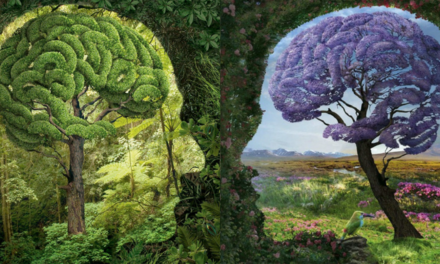
Gyanganj is believed to be located in the remote and inaccessible valley of the Himalayas. Several attempts by the Trekkers and mountaineers have been made to find its exact location. But to date, all the attempts to locate and reach this tiny village have failed. Even new age satellites and other mapping technologies have failed to locate and map Gyanganj. Buddhists believe that Gyanganj is not a place but a higher dimension.
_______________________________________________________________________
Read Also : Americans Are Sneaking Healthy Food Into Their Loved Ones’ Diets, According to a New…
________________________________________________________________________
They say that Gyanganj can only be spotted and reached by Sages, Yogis, and other worthy pious Souls. Whether this is a myth or a fact, nobody knows. Most of the people, who are living in the vicinity of the Himalayas, are not interested in the world outside. They say we watch the world through the eyes of the tourists who visit the Himalayas. Life and time move at a slow pace in the mountains. They don’t relish the restlessness in the world outside. They are happy in the mountains because there’s so much peace. How the important Himalayas is, when and how it came on his earth, how it affects the lives of people in India, let’s try to prepare a caricature of it.
Earth has a dynamic past and a unique prominence in present-day space. Let’s slice
open the earth. This geological bonbon is made of rocks and minerals. At the center is
an iron ball 2400 kilometer. in diameter. It is nearly as hot as the sun. This inner core is
wrapped in three shells. The first shell is the outer core, an ocean of liquid iron 2300
kilometers thick. Surrounding this is 2900 kilometers thick mantle (A layer of hot,
pressurized rock that contains 84% of earth’S weight and mass). Covering this mantle is a thin brittle crust on which we live. It has all the mountains, valleys, fields, riverbeds, and sea beds over it.
________________________________________________________________________
Read Also : The Great Plains of India are the rare gift of the Great Himalayas,
________________________________________________________________________
According to the theory of plate tectonics, the earth’s crest was initially a single gigantic
supercontinent called Pangea. Its northern part was the Angara land and the southern
part was Gondwana land. The convection currents split the crust into several big and
small pieces, called tectonic plates. Over a period, these plates are in movement and
kept on drifting. Thus, the Indo Australian plate after being separated from Gondwana
land drifted towards the north.
About 70 million years ago, the Indo Australian platecollided into the underbelly of the Eurasian plate, and this is how THE GREAT HIMALAYAS a geological marvel had occurred on earth. It is the highest and theyoungest mountain range in the world.
The Summit of Mount Everest is made oflimestone from the Tethys, the ancient ocean, which is completely closed by this IndoAustralian plate. Stretching in an immense arc of 2500 kilometers in length with a widthof 240 to 330 kilometers along the boundaries and covering part of five Asian countries, the Himalayas span an area of 750,000 sq. kilometers.
The great ranges of Central Asia, including the Himalayas, contain the 3rd largest
deposits of ice and snow in the world after Antarctica and Arctic. The Himalayan range
encompasses about 15000 glaciers, which store about 12000 cubic kilometers. or 2900
cubic millions of fresh-water. This region is also dotted with hundreds of lakes.
Mansarovar lake near Mount Kailash (area 420 sq. kilometers., and altitude 15060 ft.). It
drains into lake RAKSHASTAL (area of 250 sq. kilometers., and altitude 15010 ft.) are
on the northern side of the main range. Pangong lake which spreads between India and
China and always a bone of contention, at the far western end of Tibet, and Yamdrok
Tso, located in south-central Tibet, are among the largest with surface areas of 700 sq.
kilometers, and 638 sq. kilometers. respectively. Lake PUMA YAMCO is one of the
highest of the larger lakes at an elevation of 16500 ft.
_______________________________________________________________________
Read Also : High-Protein Diet: Give The Traditional Appe A Healthy Spin With Moong Dal Appe
________________________________________________________________________
Though India, Nepal, and Bhutan have sovereignty over most of the Himalayas,
Pakistan and China also occupy parts of them. In the disputed Kashmir region, Pakistan
has administrative control over 83900 sq. kilometers. of the range lying north and west
of the LOC, established in 1972. China also administers 36500 sq. kilometers. of the area in the Ladakh district of Kashmir. China is claiming more territory at the eastern
end of the Himalayas within the Indian state of Arunachal Pradesh.
The Himalayas are the most significant geographical structure of India and its existence.
It comprises the most dominating geographical feature for this country. No other
mountain range, anywhere in the world has affected the lives of people and shaped the
destiny of a nation as the Himalayas have done for India. The Himalayas is not a
mountain range, rather the body and soul of this country. The very existence of this
country is majorly dependent on the mountain system of the great Himalayas. Finally,
HIMALAYAS IS THE LIFELINE OF INDIA.








I’ve recently started a blog, the information you provide on this website has helped me tremendously. Thank you for all of your time & work.
Undeniably believe that which you stated. Your favorite reason appeared to be on the net the simplest thing to be aware of. I say to you, I certainly get annoyed while people think about worries that they plainly do not know about. You managed to hit the nail upon the top and defined out the whole thing without having side effect , people can take a signal. Will likely be back to get more. Thanks